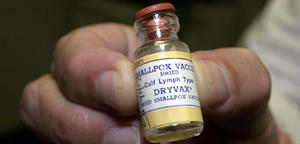SmallpoxNIH employees not notified of smallpox virus vials found at NIH Md. campus
When Food and Drug Administration(FDA) workers the other day discovered decades-old vials of smallpox virus in Building 29A on the Bethesda, Maryland campus of the National Institutes of Health(NIH), NIH officials reached out to Montgomery County officials, Maryland health officials, and senior NIH executives.No notification, however, was sent to the roughly 18,000 NIH employees who work at the agency’s main campus.

Smallpox vials found in a closet // Source: ploumistos.com
When Food and Drug Administration (FDA) workers the other day discovered decades-old vials of smallpox virus in Building 29A on the Bethesda, Maryland campus of the National Institutes of Health (NIH), NIH officials reached out to Montgomery County officials, Maryland health officials, and senior NIH executives. FDA commissioner Margaret Hamburg sent an e-mail to all FDA employees. “This is quite an unexpected and unusual incident,” she said in her e-mail. “I want to assure all FDA employees that we are taking immediate steps to further ensure the safety of our laboratories and our staff.”
The Washington Post reportsthat no notification was sent to the roughly 18,000 NIH employees who work at the agency’s main campus. One researcher said employees thought they should have been informed, despite there being no evidence of infectious-exposure risk to workers or the public. “I think the responsible thing to do would have been to inform us without us having to find out through the media,” said the researcher, who works at the clinical center on the main campus.
In 2011, the antibiotic-resistant bacteria known as Klebsiella pneumoniae spread through the NIH clinical center, but the public was informed of the incident only a year later when researchers published a scientific paper detailing how the infection was traced. NIH pledged to inform local and state officials about high-profile diseases or outbreaks.
In the recent smallpox case, an NIH spokeswoman said the agency did not notify employees because the vials were secure and did not pose a public threat, though the directors of the NIH’s twenty-seven institutes and centers were informed the morning of the discovery.
The FBI and the Centers for Disease Control and Prevention (CDC) are investigating how the smallpox samples were prepared and stored in the building. The CDC did notify all employees and contractors of the discovery, and noted that the samples will be tested in a CDC lab. Initial testing confirmed the presence of smallpox-virus DNA, but further testing, which could take up to two weeks, will determine whether the material is live. The samples will be destroyed after testing is completed.
“We’ve learned that you simply can’t overcommunicate when it comes to an event like this,” said CDC spokesman Tom Skinner. Last month, live anthrax bacteria were released accidentally at CDC labs in Atlanta. About eight-four employees working in the affected labs were advised to receive vaccines and antibiotics as a precaution, but employees working at labs adjacent to the affected areas complained that they were not notified sooner.
